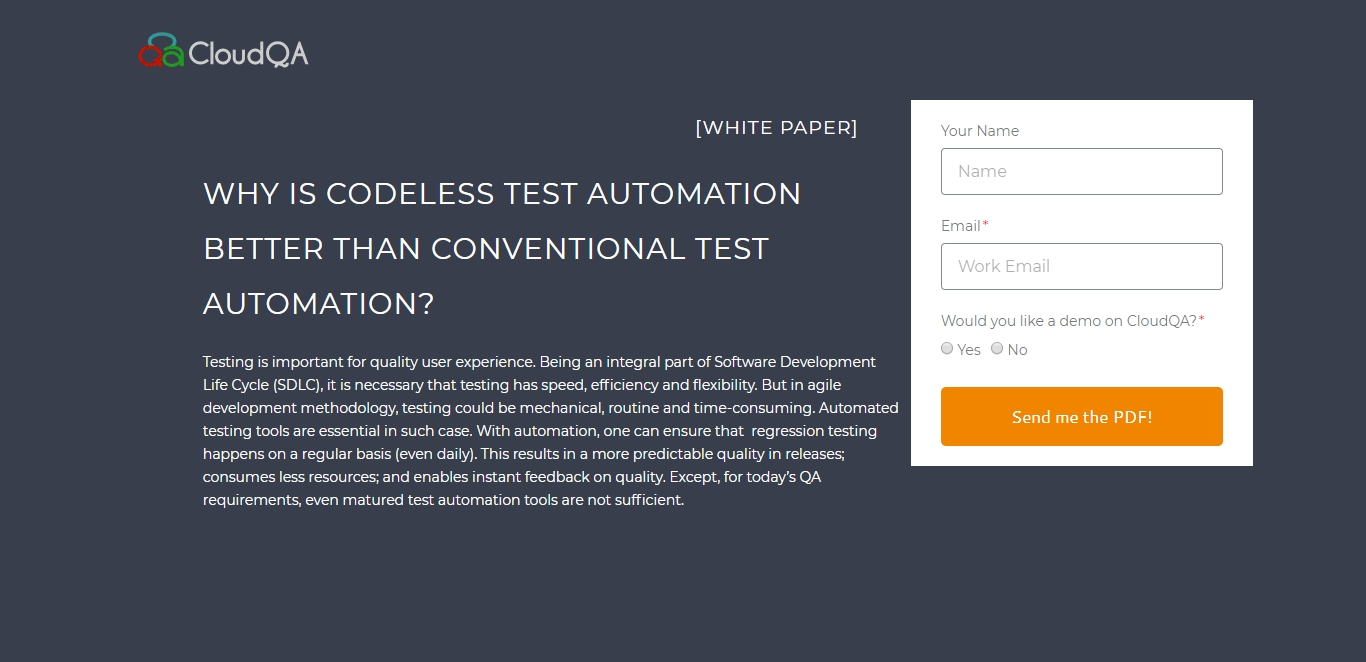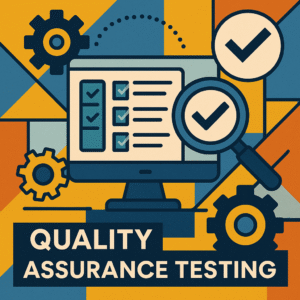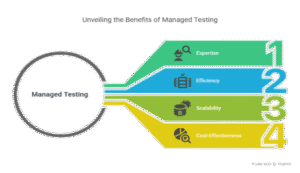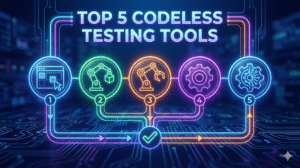Robotic Process Automation [RPA] vs Test Automation Explained
Last Updated: December 23rd 2025
Ready to find the right automation solution for your needs? Whether it’s for business processes or software testing, CloudQA’s intelligent, codeless platform can help. Discover the right tool for your team.
Is RPA a testing tool? Is Test Automation similar to RPA? Could Selenium be used for RPA? Does a Robot do RPA execution? How could RPA be utilized in testing? With RPA evolving could testers lose their job? Is RPA based on Agile?
To answer all such questions, we’ve come up with a post to debunk all myths and highlight the facts of RPA and test automation. Let’s get started with an introduction to RPA.
Table of Contents
Introduction
In today’s business landscape, “automation” is the ultimate buzzword, promising greater efficiency, reduced costs, and accelerated workflows. Two terms that are often used interchangeably in this conversation are Robotic Process Automation (RPA) and Test Automation. While both technologies involve automating tasks, their purpose, application, and underlying principles are fundamentally different. This common confusion can lead to costly mistakes, such as choosing the wrong tool for the job or having mismatched expectations.
This guide will serve as your definitive resource for understanding the critical differences between these two powerful technologies. We will debunk the most common myths and present the clear facts, helping you understand the unique role each plays. By the end, you’ll be able to confidently determine which automation approach is the right fit for your specific business or quality assurance needs.
Core Definitions: What is RPA and What is Test Automation?
Before we can debunk the myths, it’s essential to establish a clear baseline for what each term means.
What is Robotic Process Automation (RPA)?
Robotic Process Automation (RPA) is a business process automation technology that uses software “robots” or “bots” to mimic human actions and automate repetitive, rule-based business tasks. The primary goal of RPA is to improve business efficiency, reduce operational costs, and eliminate human error in day-to-day workflows.
Think of an RPA bot as a digital employee. It can be trained to perform tasks like:
- Logging into applications.
- Copying and pasting data between systems.
- Filling out forms.
- Extracting data from documents.
- Performing routine calculations.
RPA primarily interacts with the presentation layer (UI) of applications, just as a human would, and is used to automate stable, predictable business processes.
Simple RPA vs Cognitive RPA
RPA can be further categorized into simple and cognitive. Here’s how they are different:
| Simple RPA | Cognitive RPA |
| Automation of any routine tasks where there is no need of intelligence is termed as Simple RPA. For example, Data Entry jobs | Cognitive RPA involves human action/command for an RPA processing. For example, using Google assistant to find the shortest route while driving is a case of Cognitive RPA. |
What is Test Automation?
Test Automation is a software quality assurance (QA) practice that uses specialized tools to run tests on a software application and validate its functionality. The primary goal of test automation is to ensure software quality, find defects early, and accelerate the development lifecycle.
Think of a test automation script as a quality inspector. It is designed to:
- Verify that a feature works according to its specifications.
- Check for regressions (new bugs in old features).
- Validate the application across different browsers and devices.
- Test the application’s performance and security.
While it can also interact with the UI, test automation often works at the API and code level and is designed to handle applications that are constantly changing.
Ready to speed-up your business process?
Ask us on how we can help you in achieving your optimum performance
Myths of Robotic Process Automation
Myth 1: RPA and Test Automation Are the Same Thing
This is the most pervasive myth and the root of most confusion.
The Myth: Because both RPA and test automation involve bots interacting with software, many people assume they are simply two different names for the same technology. They see a bot clicking on a screen and conclude that the underlying function is identical.
The Fact: RPA and test automation have fundamentally different purposes and are designed to solve different problems.
The easiest way to understand the difference is to think about their core objectives:
- RPA’s purpose is to perform a business process. It is designed for operational efficiency. The desired outcome is a successfully completed task (e.g., an invoice has been processed).
- Test Automation’s purpose is to validate a software application. It is designed for quality assurance. The desired outcome is information (e.g., did this feature pass or fail its quality checks?).
While they may use similar underlying technologies (like object recognition), their application and intent are worlds apart. RPA is for
business operations, while test automation is for software development.
Myth 2: RPA Can Completely Replace Test Automation
This myth often follows from the first, leading some organizations to believe they can get a “two-for-one” deal.
The Myth: Since RPA bots can interact with an application’s UI, some businesses believe they can use their RPA tools to handle all of their software testing needs, eliminating the need for a dedicated test automation platform.
The Fact: RPA is not designed to handle the complexities and dynamic nature of software testing.
Using RPA for testing is like using a delivery truck to compete in a Formula 1 race. While both are vehicles, they are built for entirely different conditions. Here’s why RPA falls short as a replacement for test automation:
- Designed for Stability vs. Change: RPA works best on stable, unchanging processes. Test automation, on the other hand, is built to test applications that are constantly evolving during the development lifecycle. Dedicated testing tools have features to handle frequent UI changes, which would cause an RPA bot to fail.
- Limited Integration with Development Tools: Test automation platforms are designed to integrate seamlessly with the software development ecosystem (e.g., CI/CD pipelines, bug tracking systems). RPA tools are built to integrate with business applications (e.g., ERPs, CRMs).
- Lack of Comprehensive Test Reporting: Test automation tools provide detailed, actionable reports designed for developers and QA engineers, including logs, screenshots, and performance metrics. RPA reporting is focused on business process outcomes (e.g., number of tasks completed).
- Doesn’t Test Beyond the UI: Modern test automation goes far beyond the UI to include API testing, database testing, and performance testing. RPA is almost exclusively focused on the UI.
Myth 3: Test Automation is Only for Testers, and RPA is Only for Business Users
This myth creates unnecessary silos and prevents teams from seeing potential areas of collaboration.
The Myth: The common perception is that test automation is a highly technical discipline reserved for developers and QA engineers, while RPA is a simple tool that only business operations teams use.
The Fact: Both technologies are becoming more accessible, and the lines are blurring.
While the primary users are distinct, the reality is more nuanced:
- The Rise of Codeless Test Automation: Modern, codeless test automation platforms (like CloudQA) have drastically lowered the technical barrier. They allow business analysts and manual testers with deep functional knowledge to build and maintain automated tests without writing code.
- RPA Requires Technical Oversight: While business users often drive RPA initiatives, the implementation, scaling, and maintenance of RPA bots require technical expertise from IT or a dedicated RPA development team to ensure they are robust and secure.
The most successful organizations foster collaboration between their technical and business teams for both types of automation.
Myth 4: RPA Does Not Require Any Technical Expertise
This myth is often perpetuated by marketing that oversimplifies the reality of implementing automation at scale.
The Myth: Many believe that RPA is a “no-code” solution that can be deployed by any business user with minimal training, completely independent of the IT department.
The Fact: While creating a simple RPA bot can be easy, building, scaling, and maintaining an enterprise-grade RPA program requires significant technical skill.
Here’s what is often overlooked:
- Robustness and Error Handling: Creating a bot that can handle exceptions, recover from errors, and log its activities properly requires programming logic.
- Security and Governance: Deploying bots that interact with sensitive company data requires strict security protocols, access management, and governance, all of which are technical domains.
- Scalability: Managing a “digital workforce” of dozens or hundreds of bots requires a sophisticated technical infrastructure for scheduling, monitoring, and maintenance.
While the initial creation of a bot may be simple, a successful, long-term RPA initiative is a serious software development project that requires technical oversight.
Myth 5: Testing Tools like Selenium Could be used for RPA
The market is flooded with test automation tools like Selenium, QTP, QF-Test, etc. so could they be used as RPA tools? The short answer is NO, and the long answer is that test automation tools come with a constraint that they need software to run on. At the same time, RPA could be applied to anything except a product. Hence, none of the testing tools available in the market could serve as an RPA tool.
Myth 6: RPA can cause job losses
A report published by McKinsey Global Institute says, “The right level of detail at which to analyze the potential impact of automation is that of individual activities rather than entire occupations[…] Given currently demonstrated technologies, very few occupations—less than 5 percent—are candidates for full automation. However, almost every occupation has partial automation potential.”
This type of analysis builds hopes that the work done would be most effective when done under a condition of human collaboration with machines, so as of now we do not see RPA eating up jobs. Instead, it’s wise to automate repeatable operations previously done by people, so professionals could focus on more complex tasks which require human intelligence.
At a Glance: A Quick Comparison Table
Feature | Robotic Process Automation (RPA) | Test Automation |
Primary Goal | Automate business processes for efficiency. | Validate software functionality for quality. |
Primary User | Business operations teams. | QA engineers, SDETs, and developers. |
Application | Works on stable, production environments. | Works on applications under development that are constantly changing. |
Scope | Primarily focused on UI interactions. | Covers UI, API, database, and performance layers. |
Key Metric | Return on Investment (ROI), efficiency gains. | Test coverage, defect detection rate. |
Integration | Integrates with business software (ERP, CRM). | Integrates with development tools (CI/CD, Jira). |
Simplify your automation with CloudQA
Our miniature robots could work across various industry such as banking, insurance, health or telecom. Our solution will help you in educating, implementing, supporting and maintaining the automation of business processes. CloudQA RPA tool will have such features as easy environment set up, non-intrusive, scalable and, above all, automation of both simple and cognitive business processes.
Contact us for more information on our RPA tools.
Meanwhile, we already offer a variety of solutions for testing automation. Our products help business across different industries to scale and automate their QA through load testing, synthetic monitoring, and regression testing.
Every product is designed to be beginner friendly and highly accessible. Which means, that even businesses that don’t employ QA automation professionals can use them.
If you want to get started with testing automation today, request a free demo, and we will show you all the possibilities of our testing automation software.
Conclusion: Choosing the Right Automation for the Right Task
RPA and Test Automation are both powerful technologies, but they are not interchangeable. Understanding their distinct purposes is the key to a successful automation strategy.
- Choose RPA when your goal is to automate a high-volume, repetitive, and stable business process to increase efficiency and reduce human error.
- Choose Test Automation when your goal is to validate the quality of a software application, find bugs early in the development cycle, and accelerate your release velocity.
By demystifying these technologies and recognizing them as separate but complementary tools, organizations can make smarter investments, set realistic expectations, and unlock the true potential of automation across both their business and development operations.
Frequently Asked Questions (FAQs)
- Q1: Can RPA and test automation tools be used together?
- Yes, in some scenarios. For example, a test automation script could validate a feature, and then an RPA bot could be used to populate the test environment with the large amounts of data needed for the next round of testing. However, their core functions should remain separate.
- Q2: Our company already has an RPA tool. Can we use it for some simple testing?
- While you technically can, it’s generally not recommended. RPA tools lack the features to handle application changes gracefully and don’t provide the detailed reporting needed for effective QA. Using the wrong tool will likely lead to brittle tests and more maintenance work in the long run.
- Q3: Which is easier to learn, RPA or test automation?
- Both fields now offer user-friendly, codeless tools that are easy for beginners. The learning curve depends more on the specific platform you choose than on the category itself. However, scaling either technology to an enterprise level requires a deeper technical understanding.
Share this post if it helped!
RECENT POSTS
Guides

How To Select a Regression Testing Automation Tool For Web Applications
Regression testing is an essential component in a web application development cycle. However, it’s often a time-consuming and tedious task in the QA process.

Switching from Manual to Automated QA Testing
Do you or your team currently test manually and trying to break into test automation? In this article, we outline how can small QA teams make transition from manual to codeless testing to full fledged automated testing.

Why you can’t ignore test planning in agile?
An agile development process seems too dynamic to have a test plan. Most organisations with agile, specially startups, don’t take the documented approach for testing. So, are they losing on something?

Challenges of testing Single Page Applications with Selenium
Single-page web applications are popular for their ability to improve the user experience. Except, test automation for Single-page apps can be difficult and time-consuming. We’ll discuss how you can have a steady quality control without burning time and effort.

Why is Codeless Test Automation better than Conventional Test Automation?
Testing is important for quality user experience. Being an integral part of Software Development Life Cycle (SDLC), it is necessary that testing has speed, efficiency and flexibility. But in agile development methodology, testing could be mechanical, routine and time-consuming.






